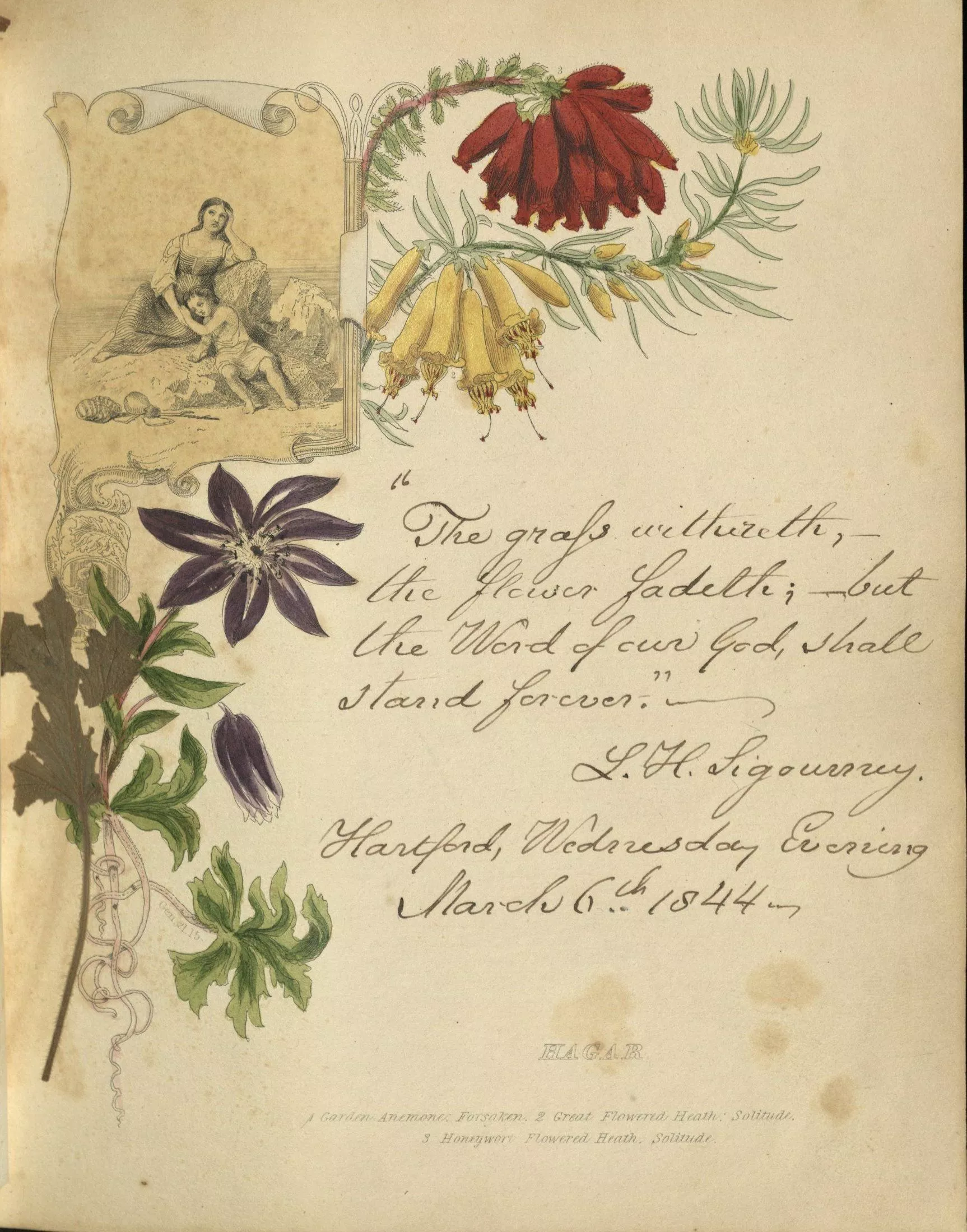Creation Date
1844-1845
Height
19 cm
Width
15 cm
Medium
Genre
Description
On this album page, a hand-colored engraving images three kinds of flowering plants. Minuscule numbers are placed beside each of three, with the numbers keyed to the plants’ names and their symbolic meanings within the nineteenth-century language of flowers, information that is relayed by the faint printing placed at the bottom of the page. The red flower at the top center of the page, labeled 3, represents the honeywort or flowered heath, which, the text instructs us, denotes “Solitude.” The yellow flower beneath it, labeled 2, images the great flowered heath, which, in the language of flowers, also denotes “Solitude.” The purple flower positioned at the left-hand side of the page, labeled 1, images a Garden Anemone, the symbol of the “Forsaken.” The unknown engraver employed for this Scriptural Album with Floral Illustrations has also pictured, folded around the stem of the garden anemone, a scroll, which displays a scene from the chapter in the Old Testament that tells us of the expulsion into the wilderness of Hagar and her son Ishmael (the notation Gen[esis] 21, 15 is just visible in type printed alongside the bottom-most tendril of the honeywort, in a reminder of the source of the story). Hagar and her son by Abraham are pictured resting on a rock, with their knapsack and the goatskin containing the little bit of water they have been permitted to carry into the desert visible on the ground before them. The flowers on the page have evidently been selected as emblems of their forlorn, outcast state. This engraver has also chosen, aiming for a trompe-l’oeil effect, to depict the top edge of the scroll that pictures Hagar’s story as though it were curling away from the surface of the page, coming unpasted. Looking at this page, we are obliged not just to notice the image but also to notice the material support that the image is on or pretends to be on.
These engraved images and these printed texts together form an elaborate frame for the blank space that the manufacturer of this blank book, J. C. Riker, left available for filling up either by the purchaser of the book or by the acquaintances who donated content to it in that purchaser’s honor. Here the blank page has been filled up with a famous autograph. The owner of this copy of the Scriptural Album, apparently named Lydia Tillinghast (a name that appears as the addressee of several of the original poems written out on other pages), has obtained for this page a handwritten inscription from the celebrated New England poet, educator, and frequent contributor to American literary annuals, Lydia Huntley Sigourney. In her phrasing for her donation to Miss Tillinghast’s album, Sigourney has conformed to the expectation for pious content that a book called a Scriptural Album seems to mandate. She has written “The grass withereth,—/ the flower fadeth;—but/ the Word of our God, shall/ stand forever” and then added her name, the place and date on which she wrote those words: “L. H. Sigourney, / Hartford, Wednesday Evening, / March 6th 1844—.” Whether intentionally or not, Sigourney’s phrasing underscores the ideological friction that is integral to J. C. Riker’s design for this album. It makes apparent a vexing contradiction: while the Scriptures might point a young woman toward eternal things, Floral Illustrations, like the flowery compliments customarily addressed to her sex, might send the young woman in another direction entirely, toward an overvaluation of transient, mundane beauty.
At some time in the history of this book, a pressed flower was also placed atop this page. Now the crumbling remains of a real leaf (withered, faded) cover up part of a painted one.
Similar engravings can be found on five other pages of the album, which image, respectively, the Old Testament stories of Rebecca, the daughter of Jephthah, and Ruth, and two scenes—the Annunciation, the Adoration of the Three Kings-- from the life of the Virgin Mary. Each of these pages, like the page devoted to Hagar, positions its picture of a female-centered Bible episode atop a mixed bouquet.
The overarching intention of the Scriptural Album with Floral Illustrations was, as an 1842 puff for J. C. Riker’s blank book stated, to “express, both by pictorial embellishment, and the all-but-vocal language of Flowers, incidents of Scripture history.” This agenda produced a book that was a hybrid, quite odd to twenty-first-century eyes, of the friendship album with, on the one hand, the illustrated Bible and, on the other hand, the kind of floral dictionary that was a steady seller in the book market on both sides of the Atlantic. In 1840 Robert Tyas, for instance, published in London The Sentiment of Flowers; or Language of Flora, while a year later Frances Sargent Osgood published, with J. C. Riker in New York, in fact, The Flowers of Poetry, and Poetry of Flowers. Each borrowed from Percy Shelley’s Queen Mab in referencing the “silent eloquence” that enabled flowers, as productions of nature, to outdo writing in their capacity to symbolize what both called “our most delicate sentiments.” Full of pictures of pretty women and pretty blooms, The Scriptural Album was sumptuously bound in red morocco leather with gilt stamping, its pages gilt-edged, the better to ensure that this book too would be a thing of beauty.
Associated Works
Copyright
1842
Publisher
J. C. Riker, New York
Collection
Accession Number
MS Am 1036, 1844-185
Additional Information
Place of creation: Most entries in the album were made in Hartford, Connecticut.

